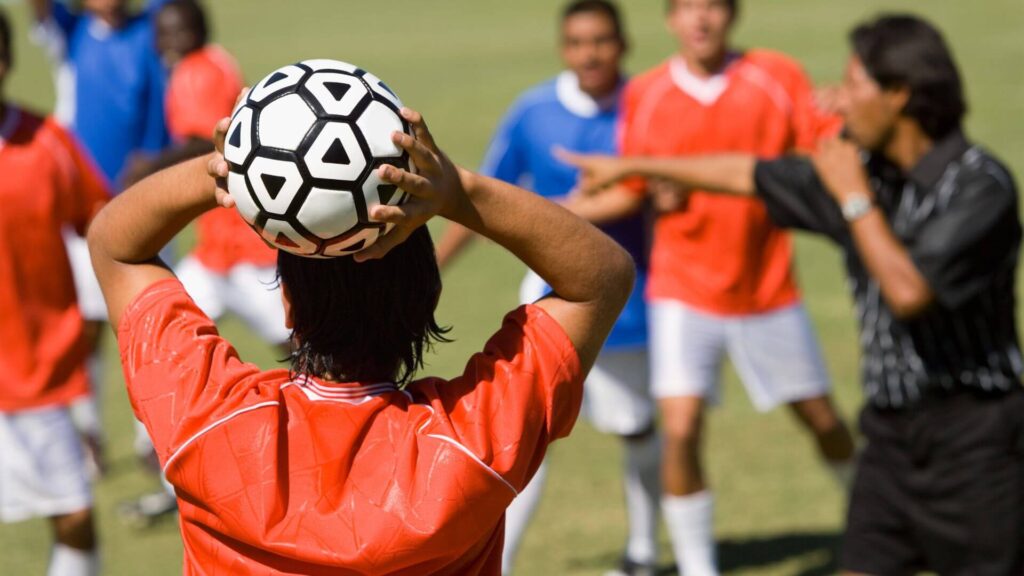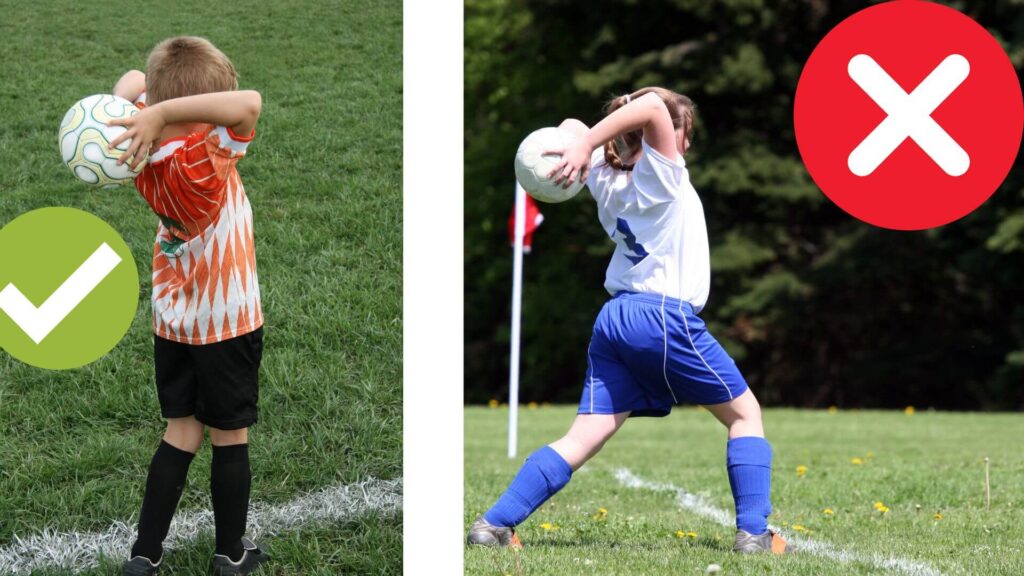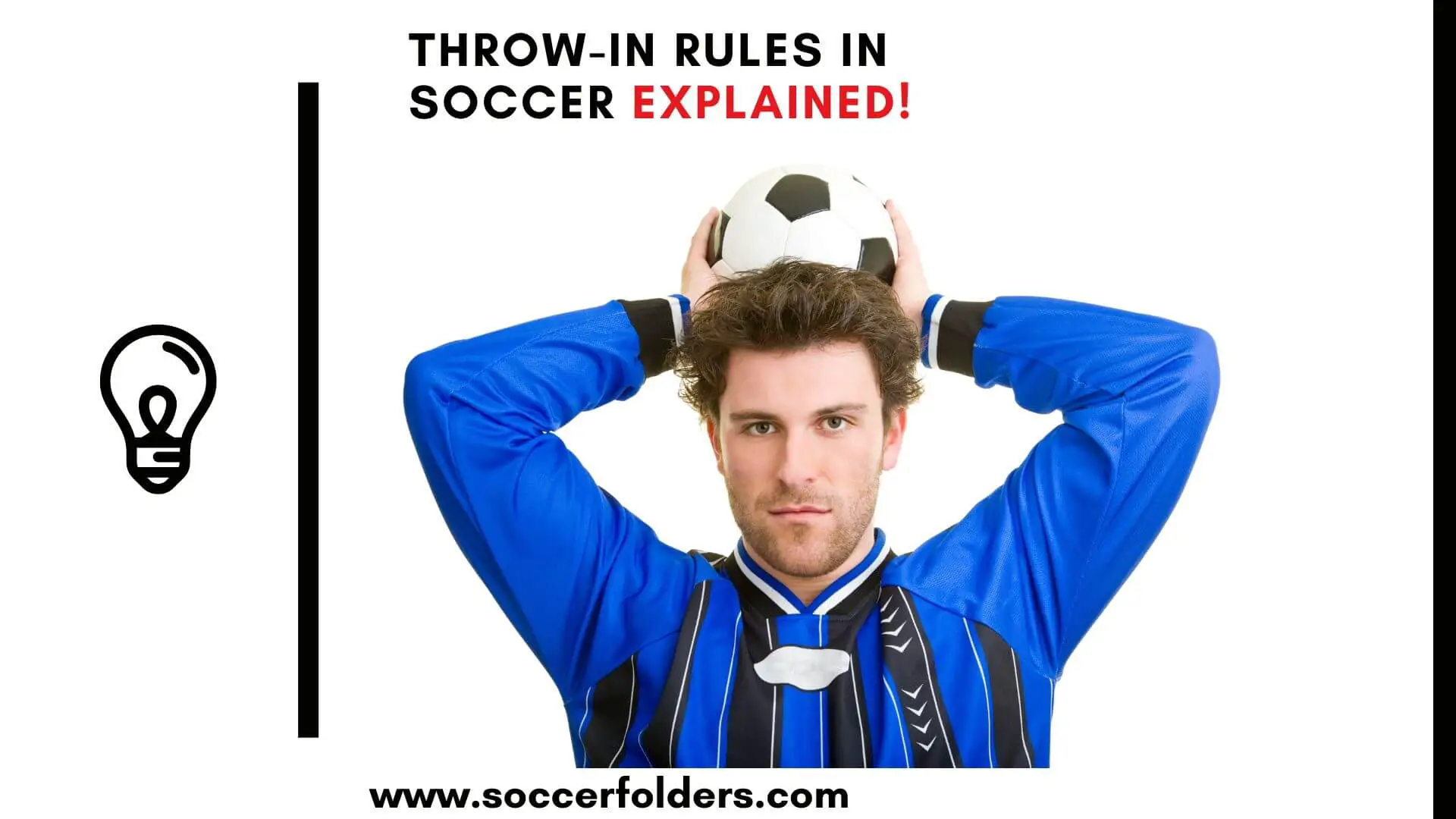Soccer, often referred to as “the beautiful game,” is a sport known for its intricate rules and exciting gameplay. One aspect that often goes overlooked but plays a significant role is the throw-in.
A well-executed throw-in can change the course of a match, making it crucial for players to understand the nuances of throw-in rules.
In this comprehensive guide, we’ll delve into the depths of Throw-In rules in soccer, uncovering the hidden gems that can give your team a competitive edge.
Table Of Contents
- The Basics of Throw-Ins
- Throw-In Rules in Soccer: Exploring the Intricacies
-
Soccer Throw-In Tips
-
Advanced Techniques for Powerful Throw-Ins
-
Tactical Insights: Leveraging Throw-Ins to Your Advantage
-
Learning from Legends: Iconic Throw-In Moments
-
Practice Drills and Exercises
-
The Evolution of Throw-In Tactics
-
FAQ: Unveiling the Secrets of Throw-In Rules in Soccer
- Final Thoughts
The Basics of Throw-Ins
Throw-ins are a fundamental part of soccer, used to restart play when the ball has crossed the touchline. The player executing the throw-in must stand with both feet on or behind the touchline while holding the ball with both hands.
It’s essential to maintain proper form during this action, as the throwing motion should be executed overhead with a fluid yet forceful movement.
Throw-In Rules in Soccer: Exploring the Intricacies

Both Feet Behind Touchline: The player taking the throw-in must keep both feet on or behind the touchline throughout the throw-in. Overstepping the line while executing the throw results in a foul.
Ball Must Be Released Overhead: The ball must be released using both hands from behind and over the player’s head. Failure to release the ball overhead can lead to an illegal throw-in.
Opponents’ Minimum Distance: Opponents must maintain a minimum distance of at least 2 meters (6.5 feet) from the throw-in taker. This distance ensures fair play and prevents interference.
No Goal Directly from Opponent’s Throw-In: If an opposing player directly scores a goal from their own throw-in without any other player touching the ball, it results in a goal kick for the opposing team.
Throw-In Retaken If Not in Play: If the ball is not in play after a throw-in (e.g., it does not enter the field of play), the throw-in is given to the opposing team. The throw-in is considered in play when the ball has left the thrower’s hands and entered the field or not.
Illegal Throw-In: An illegal throw-in occurs when a player fails to comply with the basic rules of executing a throw-in, leading to the opposing team gaining possession.
Kicking Not Allowed: Kicking the ball during a throw-in is not permitted. The act of kicking the ball during a throw-in would be considered a violation of the rules.
Any Player Can Take a Throw-In: Any player on the team that is awarded the throw-in can take it. There are no restrictions on which player can execute a throw-in.
No Time Limit, But Promptness Expected: There is no explicit time limit for executing a throw-in, but players are expected to take throw-ins promptly to maintain the flow of the game.
Throw-Ins are Direct Restart: Throw-ins are considered direct restarts, meaning the ball is immediately in play and can lead to direct scoring opportunities without intermediaries.
No Offside from Throw-In: Players receiving the ball from a throw-in cannot be offside, regardless of their positioning on the field.
Soccer Throw-In Tips

1. Proper Form Matters
Achieving maximum distance and accuracy requires mastering the proper technique.
Position your non-throwing foot behind the line, keeping contact with the ground, and lift the opposite foot slightly to maintain balance. This simple adjustment can enhance your throws significantly.
2. Location, Location, Location
A common misconception is that you must be exactly on the touchline.
However, you’re allowed a bit of leeway. Utilize this knowledge to gain a better angle and potentially create more strategic opportunities for your team.
3. Stepping Over the Line
To avoid committing a foul, refrain from stepping over the touchline until the ball has left your hands.
This may seem trivial, but in the heat of the game, a small mistake like this can lead to turnovers and missed opportunities.
4. The 1-2-3 Rule
Both feet must be on or behind the touchline throughout the throw. But did you know that you can lift your back foot slightly during the throw?
This extra inch of elevation can provide more power and accuracy, giving your teammates a better chance at gaining possession.
5. Know Your Options
While many players focus solely on throwing the ball down the line, you have the freedom to throw it anywhere within your throwing arc.
This can catch opponents off guard and create unexpected scoring opportunities.
6. The Art of Deception
During a throw-in, you can fake a long throw to confuse the opposition. This can create space for a shorter, more precise throw, giving your team the upper hand in retaining possession.
Advanced Techniques for Powerful Throw-Ins
1. The Long Throw Specialist
Becoming a long throw specialist involves a meticulous blend of core strength, body positioning, and rotational force.
This mastery transforms throw-ins into formidable attacking opportunities, providing your team with a distinct advantage. Here’s how to embrace this role:
Core Strength Enhancement:
- Exercise Routine: Engage in a comprehensive core-strengthening routine. Focus on exercises like planks, Russian twists, and leg raises to build the foundation for the explosive power required for long throw-ins.
Body Positioning Precision:
- Foot Placement: Position your non-throwing foot behind the touchline while your throwing foot is planted firmly on the ground, slightly forward.
- Angular Alignment: Angle your body diagonally toward the field. This positioning facilitates the rotational motion necessary to generate power.
Rotational Force Generation:
- Sequential Motion: As you initiate the throw, begin by rotating your hips and shoulders in the direction you intend to throw. This sequential motion is the crux of generating the required force.
- Utilize the Lower Body: Leverage the power of your lower body by driving your hips forward in coordination with the throwing motion. This kinetic chain amplifies the force generated by your core.
Release and Follow-Through:
- Overhead Release: Release the ball overhead, ensuring both feet remain behind the touchline throughout the throw.
- Follow-Through: Allow your body to naturally follow through the motion, maintaining balance and control as the ball leaves your hands.
2. Crafting Curve and Spin
Adding spin and curve to your throws can be a game-changer, confusing defenders and guiding the ball precisely. Here’s how to master this technique:
Spin for Precision:
- Grip Adjustment: Hold the ball with your fingers on one side and your thumb on the other. Slightly tilt the ball towards the side you want the ball to spin towards.
- Spin Mechanics: As you release the ball, flick your wrist in the direction you want the ball to spin. The spinning motion imparts stability and accuracy to the trajectory.
Curve for Deception:
- Grip and Release: Hold the ball with a firm grip and slightly tilt it to one side. As you release, apply a subtle pushing motion with your fingers on the tilted side to create the curving effect.
- Body and Arm Motion: Incorporate a slight sweeping motion with your arm towards the opposite direction of the curve. This synchronized movement accentuates the curve.
Practice and Patience:
- Repetition: Regular practice is key. Experiment with different angles, spins, and curves during practice sessions to refine your technique.
- Trial and Error: Understand that mastering spin and curve takes time. Be patient and open to making adjustments based on the results you observe.
By diligently working on these techniques, you’ll be well on your way to becoming a long throw specialist and a master of crafting spin and curve. Your throws will evolve from routine restarts into dynamic assets that keep defenders guessing and provide your team with a potent offensive edge.
Tactical Insights: Leveraging Throw-Ins to Your Advantage
1. Set-Piece Scenarios
Elevating throw-ins to set-piece artistry involves unveiling strategic strategies that transform ordinary throw-ins into orchestrated movements akin to corner kicks or free kicks.
The objective is to capitalize on the synchronized execution of players to create optimal goal-scoring opportunities. Here’s a detailed explanation:
Coordinated Movement:
- Designated Roles: Assign specific roles to players during a set-piece throw-in. This could include players making runs toward the goal, creating decoy runs, or positioning themselves strategically to receive the throw.
Triggering Calculated Movements:
- Timing is Key: Perfect the timing of throws and movements. Execute the throw-in just as the designated players begin their runs. This coordination maximizes the chances of successful connections and goal-scoring opportunities.
Varying the Routine:
- Deceptive Patterns: Keep opponents guessing by varying the routines. Incorporate quick throw-ins, unexpected movements, and creative plays that defy predictability. The element of surprise can catch defenders off guard.
Synergy in Synchronized Execution:
- Seamless Integration: Work on seamless execution that involves perfect communication among players. The thrower and receivers must be in sync, with each movement complementing the others to create a harmonious play.
2. Play Switching Precision
Uncovering the tactical prowess of switching play through throw-ins involves using strategic positioning, intuitive decision-making, and impeccable timing to exploit gaps, disrupt opponents’ defensive structures, and transition swiftly into attack mode. Here’s a comprehensive breakdown:
Strategic Positioning:
- Assessing the Field: Analyze the field to identify open spaces and potential mismatches in the opponents’ formation. Choose the side of the field that offers the most advantageous position for a quick transition.
Intuitive Decision-Making:
- Read the Game: Develop the ability to read the game in real-time. Assess the movement of opponents and teammates to make split-second decisions regarding the direction and intensity of your throw-in.
Disrupting Defensive Structures:
- Quick Throws: Opt for quick throw-ins to catch defenders off guard while they are transitioning from offense to defense. This disrupts their formation and creates opportunities to exploit spaces.
Transitioning to Attack Mode:
- Counter-Attack Initiatives: Use throw-ins strategically to initiate counter-attacks. Identify players who can swiftly move into attacking positions and use your throw-in to swiftly launch the attack.
Precision and Timing:
- Timing is Everything: Execute throw-ins with impeccable timing. Ensure that your players are ready to receive the throw, and that the throw itself arrives at the opportune moment to maximize the effectiveness of the switch.
Fluid Movement and Momentum:
- Maintaining Momentum: Ensure that the throw-in is delivered with enough power and accuracy to maintain the momentum of the play. The ball should reach the intended player swiftly and smoothly to avoid disruptions.
By embracing these strategies, players can harness the potential of throw-ins not only as restarts but as strategic assets that enable seamless transitions, disrupt opponents’ defenses, and ultimately pave the way for swift and effective attacks.
Overcoming Challenges and Common Mistakes
2. Avoiding Foul Play
To sidestep common mistakes that lead to throw-in fouls, players must pay meticulous attention to key aspects like foot positioning, line clearance, and sequential hand-to-ball motion. Upholding proper form ensures that unnecessary turnovers are eliminated and opportunities are capitalized upon. Here’s a detailed guide:
Foot Positioning:
- Stay In-Bounds: Ensure that both feet remain on or behind the touchline until the ball is released. This prevents overstepping the line and committing a foul.
Line Clearance:
- Maintain Contact: Keep at least part of each foot in contact with the ground as you execute the throw. This ensures that you stay within the boundaries and avoid overstepping.
Sequential Hand-to-Ball Motion:
- Proper Sequence: Use both hands to throw the ball overhead. The hands should work together in a fluid motion without interruption. This sequential motion adheres to the rules and avoids foul play.
Awareness of Opponents:
- Anticipate Pressure: Be mindful of nearby opponents and their positioning. Adjust your throw to avoid throwing the ball directly into the reach of a rival player.
Patience and Composure:
- Avoid Rash Movements: Take your time during the throw-in. Avoid rushed motions that can lead to accidental fouls due to lack of control.
Learning from Legends: Iconic Throw-In Moments
1. Roberto Carlos’s Pinpoint Precision
Reflecting Roberto Carlos’s iconic throw-ins unveils a masterful display of accuracy that propelled the ball with unmatched precision into the heart of opponents’ territory.
His refined techniques are a testament to the transformative impact of mastering throw-ins. Here’s an in-depth analysis:
Technique Precision:
- Mechanical Mastery: Roberto Carlos’s throw-ins were marked by impeccable mechanics. He maintained a consistent throwing arc, ensuring that the ball followed a controlled trajectory.
Grip and Release:
- Exactitude in Execution: Carlos’s grip on the ball was strategic, allowing him to release it with the perfect combination of force and finesse. His fingers and wrists contributed to the desired precision.
Angular Adjustment:
- Innovative Angles: Roberto Carlos’s ability to adjust the angle of his throws contributed to their accuracy. By tweaking the angle, he could pinpoint his targets with astonishing reliability.
Adaptive Tactics:
- Strategic Awareness: Carlos’s throw-ins weren’t limited to a single approach. He adapted his techniques based on match situations, opponents, and positioning of teammates.
Confidence and Mastery:
- Practice and Persistence: Roberto Carlos’s consistent practice and dedication to honing his throw-in skills allowed him to execute with supreme confidence. His mastery became evident on the field.
2. Delap’s Power Play
Rory Delap’s unparalleled power throws left an indelible mark on soccer, showcasing his unique ability to launch throws resembling aerial assaults.
His method harnessed raw strength to redefine the scope of throw-ins. Here’s a closer look:
Explosive Power:
- Core Strength Amplification: Delap’s throws were a result of exceptional core strength. His ability to generate explosive power from his core propelled the ball over remarkable distances.
Dynamic Body Mechanics:
- Fluid Motion: Delap’s body mechanics were dynamic and synchronized. His lower body movement added momentum to his throws, amplifying their power.
Maximizing Momentum:
- Fluid Motion: Delap’s body mechanics were dynamic and synchronized. His lower body movement added momentum to his throws, amplifying their power.
Strategic Targeting:
- Pinpoint Direction: Delap’s throws were more than just long distances. His precision in targeting specific areas enabled his teammates to capitalize on his throws effectively.
Innovation and Legacy:
- Changing the Game: Delap’s style of throw-ins became synonymous with game-changing tactics. His legacy redefined the strategic potential of throw-ins.
Witnessing the prowess of Carlos’s precision and Rory Delap’s power throws underscores the transformative nature of mastering throw-ins.
Carlos’s accuracy and Delap’s raw strength not only left a significant impact on their respective teams but also redefined the strategic scope of throw-ins within soccer.
Practice Drills and Exercises
1. Personalized Training Regimens
Discovering personalized drills to amplify your throw-in proficiency empowers players to enhance their skill set and forge their unique path toward mastery.
These exercises encompass a range of aspects, from honing form to expanding throwing range. Here’s a detailed explanation:
Identifying Strengths and Weaknesses:
- Self-Assessment: Begin by assessing your current throw-in skills. Identify areas where you excel and aspects that need improvement. This self-awareness forms the foundation for your training regimen.
Targeted Form Improvement:
- Form Refinement: Focus on honing the fundamental technique of executing a throw-in. Work on aspects such as foot positioning, body alignment, and the sequential hand-to-ball motion.
Core and Upper Body Strengthening:
- Strengthening Exercises: Incorporate exercises that bolster your core and upper body strength. These exercises contribute to the power and accuracy of your throws.
Progressive Range Expansion:
- Gradual Distance Increase: Start with short throws and gradually expand your range. Consistent practice at varying distances enhances your ability to throw with precision and power.
Consistency and Repetition:
- Regular Practice: Dedicate time to consistent practice. Repetition is crucial for muscle memory, allowing you to execute throws effortlessly in a game scenario.
Mental Focus and Visualization:
- Mental Rehearsal: Combine physical practice with mental rehearsal. Visualize successful throws and imagine the entire process, from approach to release.
2. Evolution of Tactics
Embarking on a historical voyage through the evolution of throw-in tactics provides insights into how strategies have adapted over time, incorporating innovative variations and inspiring fresh approaches that have left an indelible mark on the sport.
Here’s a comprehensive analysis:
Early Beginnings:
- Simple Restarts: In the early days of soccer, throw-ins were basic restarts, with players simply throwing the ball back into play.
Strategic Innovations:
- Creating Space: Over time, teams began to recognize the potential of throw-ins to create space. Strategically positioning players and incorporating quick throws started to shape tactics.
Tactical Set Pieces:
- Set-Piece Approaches: Throw-ins evolved into tactical set pieces, akin to free kicks and corner kicks. Coordinated movements and precise timing transformed throw-ins into goal-scoring opportunities.
Innovative Variations:
- Quick Throws and Deceptions: Teams introduced quick throws to catch opponents off guard. Deceptive throw-ins with unexpected trajectories and movements added an element of surprise.
Modernization and Specialization:
- Specialist Throwers: Teams began utilizing players with unique throw-in abilities as specialists. Their prowess led to innovative techniques, such as long throws and power throws.
Adaptation to Opponents:
- Tailored Strategies: Teams started adapting throw-in tactics based on opponents’ weaknesses. The evolution continues with strategies that exploit gaps and disrupt opponents’ defensive structures.
The Evolution of Throw-In Tactics
1. Historical Perspective
From the early days of the sport to the modern era, throw-in tactics have transformed under the influence of changing rules, evolving tactics, and the emergence of player specialization.
Here’s a comprehensive overview:
Early Beginnings:
- Simplicity in Origins: In soccer’s nascent stages, throw-ins were rudimentary, serving as a means to restart play when the ball went out of bounds.
Strategic Growth:
- Tactical Recognition: As the game evolved, teams began recognizing the strategic potential of throw-ins. Basic strategies emerged, like placing players in advantageous positions to receive throw-ins.
Rule Influences:
- Evolution of Rules: Changes in soccer’s rules impacted throw-ins. From establishing the two-handed throw rule to specifying that both feet must be on or behind the touchline, regulations refined the execution of throw-ins.
Tactical Revolution:
- Formation Influence: As formations evolved, so did throw-in tactics. Teams used throw-ins to transition from defense to attack, laying the groundwork for modern set-piece strategies.
2. Innovation and Adaptation
Coaches and players have continually pushed the boundaries of conventional techniques to suit their playing styles and exploit opponents’ weaknesses.
This innovation has led to the introduction of creative variations that reshape the throw-in landscape. Here’s an in-depth exploration:
Playing Style Fusion:
- Style Integration: Teams have blended throw-in tactics with their playing style. Possession-oriented teams may employ short, quick throws to maintain ball control, while direct teams might opt for powerful, long throws.
Exploiting Weaknesses:
- Strategic Exploitation: Coaches identify opponents’ vulnerabilities and tailor throw-in strategies to exploit those weaknesses. For instance, launching surprise long throws towards an opponent’s shaky defense.
Quick Throw-Ins:
- Instant Restart: Innovations like quick throw-ins have altered the tempo of matches. By swiftly returning the ball to play, teams can catch opponents off guard and maintain momentum.
Surprise Variations:
- Unpredictable Tactics: Coaches introduce surprise variations to disrupt opponents’ anticipation. Unexpected throw-in trajectories, movement patterns, and sudden plays can change the course of a game.
Specialist Roles:
- Throw-In Specialists: The emergence of throw-in specialists showcases player specialization. Players with unique throw-in abilities, whether for power or precision, contribute a new dimension to tactics.
FAQ: Unveiling the Secrets of Throw-In Rules in Soccer
Q1: What is an illegal throw-in?
An illegal throw-in occurs when a player fails to comply with the basic rules of executing a throw-in. This includes lifting both feet off the ground, stepping over the touchline before the ball is released, or not using both hands to throw the ball. In essence, any deviation from the prescribed technique outlined in the rules results in an illegal throw-in, leading to the opposing team gaining possession of the ball.
Q2: Can you kick a throw-in in soccer?
No, in soccer, a throw-in must be executed by using both hands to throw the ball over the head. Kicking the ball during a throw-in is not permitted. The act of kicking the ball during a throw-in would be considered a violation of the rules, resulting in the opposing team being awarded possession.
Q3: Can any player take a throw-in?
Yes, any player on the team that is awarded the throw-in can take it. This provides teams with flexibility in choosing the best player for the specific situation, whether it’s a player with a strong and accurate throw or one who can quickly restart play.
Q4: Can you score a goal with a throw-in?
While you cannot directly score a goal from a throw-in, the ball can indirectly lead to a goal. If a player’s throw-in enters the opponent’s goal directly without being touched by another player, it results in a goal kick for the opposing team. However, a skillfully executed throw-in that leads to a teammate scoring is a classic example of how throw-ins can set up goal-scoring opportunities.
Q5: Is there a time limit on throw-ins in soccer?
While there is no explicit time limit for executing a throw-in, players are expected to perform the throw-in within a reasonable timeframe. Delays in taking a throw-in can result in a verbal warning from the referee or even a yellow card if the delay is considered deliberate time-wasting. To maintain the flow of the game, players should aim to take throw-ins promptly.
Q6: Can you be offside from a throw-in?
No, you cannot be offside directly from a throw-in. The offside rule applies only when a player is involved in active play after a teammate intentionally plays the ball.
Q7: Are throw-ins direct or indirect?
Throw-ins are considered direct restarts. This means that once the ball is thrown into play, it is considered active play, and players can immediately engage with the ball without any need for a second touch.
Final Thoughts
In the realm of soccer, throw-ins are more than just a mundane restart of play—they’re a strategic weapon that can be wielded with precision to gain an advantage.
Mastering throw-in rules in soccer requires dedication and practice, but the rewards are immense.
From the thrill of a well-executed deception to the satisfaction of creating a game-changing opportunity, throw-ins offer players a chance to leave an indelible mark on the field.
So, embrace the nuances, hone your technique, and let your throw-ins tell a story that will resonate through the annals of soccer history.
You might also like these articles:


